Displaying items by tag: National Yacht Club
Busy Autumn Sailing Scene in Dun Laoghaire
Is Dun Laoghaire Harbour a busier dinghy sailing venue on Autumn Sundays than it is in Summer? Certainly if yesterday's activity at the National Yacht Club, Royal St. George YC, Royal Irish, Irish National Sailing School and DMYC is anything to go by.
While Anthony O'Leary was winning the All Ireland sailing championships just off the harbour mouth there was no less than six other fleets racing or race training in and around the east coast port. Just as the season is meant to be tapering off Fireflies were team racing from the Royal St. George Yacht Club and Fireballs were giving 'just for fun' demo sails from the DMYC but far and away the main point of interest in the NYC was for the Jelly Bean Junior Regatta (pictured above) that had a variety of fleets racing across the harbour.
In addition Laser 4.7s were training in Scotsman's Bay and a number of foiling Moths came out to play when the breeze puffed up to 15 knots yesterday afternoon. A perfect breeze to give the INSS novices plenty of fun on the east bight in colourful Laser Pico dinghies.
If there was any disappointment it was that there were few – if any at Ireland's biggest sailing centre – that ventured out to spectate at a thrilling final of the All Ireland Sailing Championships but that's because Dun Laoghaire sailors were all too busy sailing themselves?
Slack Winds No Obstacle for All Ireland Helmsmen on Dublin Bay
All Ireland Sailing Champion Anthony O'Leary will defend his Irish Sailing Association title after finishing top of his qualifying group in the first day of the weekend championships at the National Yacht Club in Dun Laoghaire today.
After a day of slack winds on Dublin Bay six finalists from a fleet of 16 is made up of four keelboat and two dinghy helmsmen.
In group A, RS400 dinghy champion Alex Barry; Flying Fifteen champion Dave Gorman and Alan Henry of the IDRA 14s qualify for tomorrow's final while in group B it's O'Leary, ICRA's Cillian Dixon and Chris Helme of the Ruffians who go through.
Six qualifying races were sailed with only two minutes separating first and last place in any of the races despite trying conditions that started this morning shrouded in fog.
Two more helmsmen will qualify from a line–up of eight in repechage rounds yet to be sailed in supplied J/80 keelboats.
The forecast for tomorrow is for more light south–easterlies but scheduled to strengthen significantly for the finals tomorrow evening.
Read WMN Nixon's All Ireland preview
Results to date:
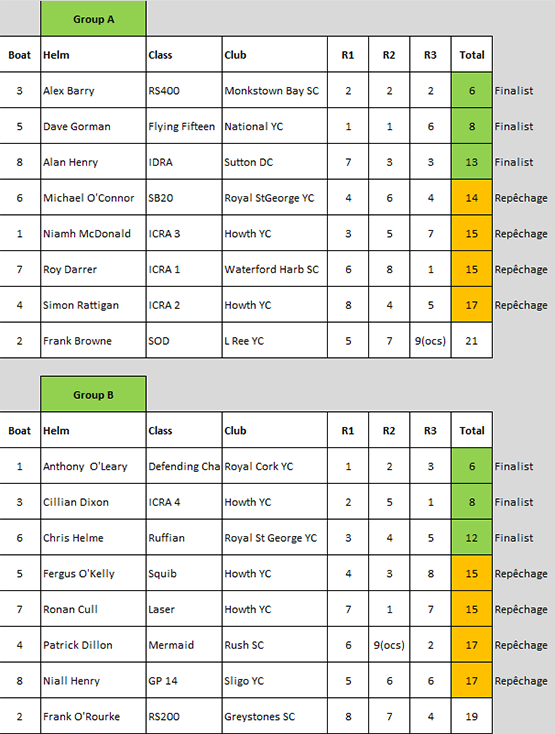
This weekend’s two-day All-Ireland Sailing Championship at the National Yacht Club in Dun Laoghaire, racing boats of the ISA J/80 SailFleet flotilla, is an easy target for facile criticism. Perhaps because it tries to do so much in the space of only two days racing, with just one type of boat and an entry of 15 class championship-winning helms, inevitably this means it will be seen by some as falling short of its high aspiration of providing a true Champion of Champions.
Yet it seldom fails to produce an absolute cracker of a final. Last year, current defending champion Anthony O’Leary of Cork, racing the J/80s in Howth and representing both ICRA Class 0 and the 1720 Sportsboats, snatched a last gasp win from 2013 title-holder Ben Duncan of the SB20s, thereby rounding out an utterly exceptional personal season for O’Leary which saw him go on to be very deservedly declared the Afloat.ie “Sailor of the Year” 2014.
So this year, with a host of younger challengers drawn from a remarkable variety of sailing backgrounds, the ever-youthful Anthony O’Leary might well see himself in the position of the Senior Stag defending his territory against half a dozen young bucks who will seem to attack him from several directions. And with winds forecast to increase in strength as the weekend progresses, differing talents and varying levels of athletic ability will hope to experience their preferred conditions at some stage, thereby getting that extra bit of confidence to bring success within their reach. It’s a fascinating scenario, and W M Nixon tries to set this unique event in perspective.
When the founding fathers of modern dinghy racing in Ireland set up the Irish Dinghy Racing Association (now the ISA) in 1946, they would have been reasonably confident that the immediate success of their new pillar event, the Helmsman’s Championship of Ireland, gave hope that a contest of this stature would still be healthily in being, and still run on a keenly-followed annual basis, nearly seventy years later.
They might even have been able to envisage that it would have been re-named the All-Ireland Championship, even if their original title of Helmsman’s Championship had a totally unique and clearly recognisable quality, for they’d have accepted its fairly harmless gender bias was going to create increasing friction with the Politically Correct brigade.
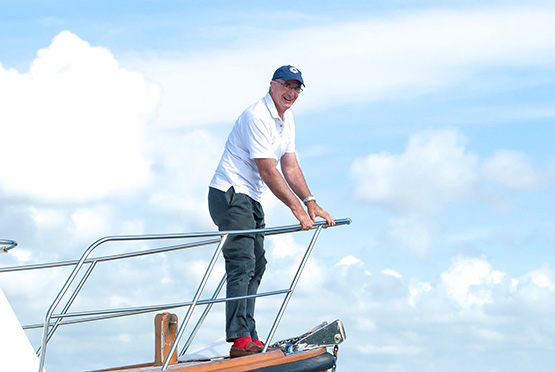 The Stag at Bay? Anthony O’leary sniffs the breeze last weekend, in charge of racing in the CH Marine Autumn league. This weekend he defends his All-Ireland title in Dun Laoghaire. Photo: Robert Bateman
The Stag at Bay? Anthony O’leary sniffs the breeze last weekend, in charge of racing in the CH Marine Autumn league. This weekend he defends his All-Ireland title in Dun Laoghaire. Photo: Robert Bateman
 Sailing should be fun, and run with courtesy – invitation to enjoyable racing, as displayed last weekend in Cork on Anthony O’Leary’s Committee Boat. Photo: Robert Bateman
Sailing should be fun, and run with courtesy – invitation to enjoyable racing, as displayed last weekend in Cork on Anthony O’Leary’s Committee Boat. Photo: Robert Bateman
But what those pioneering performance dinghy racers in 1946 can scarcely have imagined was that, 69 years later, no less than a quarter of the coveted places in the All-Ireland Championship lineup of 16 sailing stars would be going to helms who have qualified through winning their classes within the Annual National Championship of a thirteen-year-old all-Ireland body known as the Irish Cruiser-Racing Association.
And if you then further informed those great men and women of 1946 that those titles were all won in an absolute humdinger of a four-day big-fleet national championship staged in the thriving sailing centre and Irish gourmet capital of Kinsale, they’d have doubted your sanity. For in the late 1940s, Kinsale had slipped almost totally under the national sailing radar, while the town generally was showing such signs of terminal decline that there was little enough in the way of resources to put any food on any table, let alone think in terms of destination restaurants.
So in tracing the history of this uniquely Irish championship (for it long pre-dates the Endeavour Trophy in England), we have a convenient structure to hold together a manageable narrative of the story of Irish sailboat racing since the end of World War II. Add in the listings of the Irish Cruising Club trophies since the first one was instituted in 1931, then cross-reference this info with such records as the winners of the Round Ireland race and the Dun Laoghaire to Dingle Race, beef it all up with the winners of the national championship of the largest dinghy and inshore keelboat classes, and a comprehensible narrative of our national sailing history emerges.
 The veteran X332 Equinox (Ross McDonald) continues to be a force in Irish cruiser-racing, and by winning her class in the ICRA Nationals in Kinsale at the end of June, Equinox is represented in the All Irelands this weekend by helmsman Simon Rattigan. Photo: W M Nixon
The veteran X332 Equinox (Ross McDonald) continues to be a force in Irish cruiser-racing, and by winning her class in the ICRA Nationals in Kinsale at the end of June, Equinox is represented in the All Irelands this weekend by helmsman Simon Rattigan. Photo: W M Nixon
It’s far from perfect, but it’s a defining picture nevertheless, even if it lacks the inside story of the clubs. Be that as it may, in looking at it properly, we get a greater realization that the All-Ireland Helmsman’s Championship (or whatever you’re having yourself) is something very important, something to be cherished and nurtured from year to year.
Of course I’m not suggesting that we should all be out in Dublin Bay today and tomorrow on spectator boats, avidly watching every twist and turn as eight identical boats race their hearts out with a variety of helms calling the shots. Unless you’re in a particular helmsperson’s fan club, it’s really rather boring to watch from end to end, or at least until the conclusion of each stage and then the final races.
This is very much a sport for the “edited highlights”. The reality is that no matter how they try to jazz it up, sailing is primarily of interest only to those actively taking part, or directly engaged in staging each event. When great efforts are made to make it exciting for casual spectators, it costs several mints and results in rich people and highly-resourced teams engaged in costly and often unseemly battles to which genuine sporting sailors cannot really relate at all.
But with its exclusion of Olympic and some High Performance squad members, the All-Ireland in its current form is the quintessence of Irish local and national sailing. It’s almost compulsive for its participants, it provides an extra interest for their supportive clubmates, and in its pleasantly low key way it’s a genuine expression of real Irish sailing, the sailing of L’Irlande profonde.
So of course we agree that it might be more interesting for the bright young people if it was raced in something more trendy like the RS400s if they could find sufficient owners to risk their boats in this particular bear pit. And yes indeed, the ISA Discussion Paper and Helmsmans Guidelines of 2012 did indeed hope that within three years, the All Ireland would be staged in dinghies.
But we have to live in the real world. Sailing really is a sport for life, and some of our best sailors are truly seniors who would be disadvantaged if it was raced in a boat making too many demands on sheer athleticism, for which the unattainable Olympic Finn would be the only true answer.
But in any case, if you watch J/80s racing in a breeze, there’s no doubting the advantage a bit of athletic ability confers, yet the cunning seniors can overcome their lack of suppleness and agility with sheer sailing genius.
 While they may be keelboats, in a breeze the J/80s will sail better with some athleticism, as displayed here by Ben Duncan (second left) as he sweeps toward the finish and victory in the 2013 All Irelands at Howth. Photo: Aidan Tarbett
While they may be keelboats, in a breeze the J/80s will sail better with some athleticism, as displayed here by Ben Duncan (second left) as he sweeps toward the finish and victory in the 2013 All Irelands at Howth. Photo: Aidan Tarbett
 Yet a spot of sailing genius can offset the adverse effects of advancing years – Anthony O’Leary (right) with Dylan Gannon (left) and Dan O’Grady after snatching victory at the last minute in 2014. Photo: Jonathan Wormald.
Yet a spot of sailing genius can offset the adverse effects of advancing years – Anthony O’Leary (right) with Dylan Gannon (left) and Dan O’Grady after snatching victory at the last minute in 2014. Photo: Jonathan Wormald.
But another reality we have to accept is that Ireland is only just crawling out of the Great Recession. And in that recession, it was the enduring competitiveness of ageing cruiser-racers and the sporting attitude of their owners which kept the national sailing show on the road. Your dyed-in-the-wool dinghy sailor may sneer at the constrictions of seaborn truck-racing. But young sailors who were realists very quickly grasped that if they wanted to get regular sailing with good competition as the Irish economy went into free fall, then they had to hone their skills in making boats with lids, crewed by tough old birds most emphatically not in the first flush of youth, sail very well indeed.
Thus in providing a way for impecunious young people to keep sailing through the recession, ICRA performs a great service for Irish sailing. And the productive interaction between young and old in the ICRA fleets, further enlivened by their different sailing backgrounds, has resulted in a vibrant new type of sailing community where it is regarded as healthily normal to be able to move between dinghies and keelboats and back again.
The final lineup of entries is a remarkable overview of the current Irish racing scene, and if you wonder why the winner of the GP14 British Opens 2015, Shane McCarthy of Greystones, is not representing the GP 14s, the word is he’s unavailable, so his place is taken by Niall Henry of Sligo.
2014 Champion Anthony O'Leary, RCYC
RS400 Alex Barry, Monkstown Bay SC
GP14 Niall Henry ,Sligo Yacht Club
Shannon OD Frank Browne, Lough Ree YC
Flying Fifteen David Gorman, National YC
Squib Fergus O'Kelly, Howth YC
ICRA 1 Roy Darrer, Waterford Sailing Club
Mermaid Patrick, Dillon Rush SC
Laser Std Ronan Cull, Howth YC
SB20 Michael O'Connor, Royal St.George YC
IDRA14 Alan Henry, Sutton DC
RS200 Frank O'Rourke, Greystones SC
ICRA 2 Simon Rattigan, Howth YC
ICRA 4 Cillian Dickson, Howth YC
Ruffian Chris Helme, Royal St.George YC
As a three-person boat with a semi-sportsboat performance, the J/80 is a reasonable compromise between dinghies and keelboats, and the class has the reputation of being fun to sail, which is exactly what’s needed here.
The Sailing Olympics and the ISAF Worlds may be terribly important events for sailing in the international context, but nobody would claim they’re fun events. Equally, though, you wouldn’t dream of suggesting the All-Ireland is no more than a fun event. But it strikes that neat balance between tough sport and sailing enjoyment to make it quite a good expression of the true Irish amateur sailing scene.
Inevitably from time to time it produces a champion whose sailing abilities are so exceptional that it would amount to a betrayal of their personal potential for them not to go professional in some way or other. But fortunately sailing is such a diverse world that two of the outstanding winners of the Helmsman’s Championships of Ireland have managed to make their fulfilled careers as top level professional sailors without losing that magic sense of fun and enjoyment, even though in both cases it has involved leaving Ireland.
Their wins were gained in the classic early Irish Yachting Association scenario of a one design class which functioned on a local basis being able to provide enough reasonably-matched boats to be used for the Helmsman’s, and the three I best remember were when Gordon Maguire won in 1982 on Lough Derg racing Shannon One Designs, then in the 1970s Harold Cudmore won on Lough Neagh racing Flying Fifteens, and in 1970 itself, a very young Robert Dix was winner racing National 18s at Crosshaven.
Gordon Maguire was the classic case of a talented sailor having to get out of Ireland to fulfill himself. His win in 1982 in breezy conditions at Dromineer in Shannon One Designs, with Dave Cummins of Sutton on the mainsheet, was sport at its best, though I doubt that some of the old SODs were ever the better again after the hard driving they received.
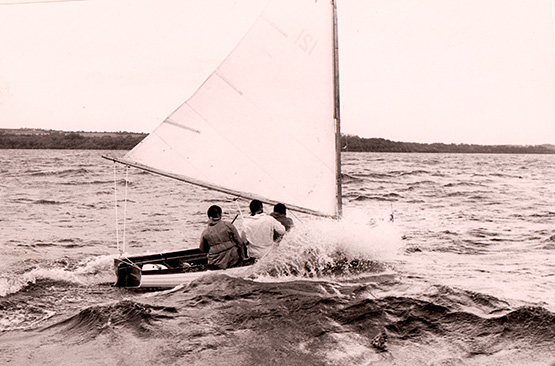 Driving force. Gordon Maguire going indecently fast for a Shannon One Design, on his way to winning the Helmsmans Championship of Ireland at Dromineer in 1982. Photo: W M Nixon
Driving force. Gordon Maguire going indecently fast for a Shannon One Design, on his way to winning the Helmsmans Championship of Ireland at Dromineer in 1982. Photo: W M Nixon
Then Gordon spread his wings, and won the Irish Windsurfer Nationals in 1984 - a great year for the Maguires, as his father Neville (himself a winner of the Helmsmans Championship five times) won the ISORA Championship with his Club Shamrock Demelza the same weekend.
But Gordon needed a larger canvas to demonstrate his talents, and in 1991 he was a member of the Irish Southern Cross team in Australia, a series which culminated in the Sydney-Hobart Race. The boat which Maguire was sailing was knocked out in a collision with another boat (it was the other boat’s fault), but Maguire found a new berth as lead helm on the boat Harold Cudmore was skippering for the Hobart Race, and they won that overall.
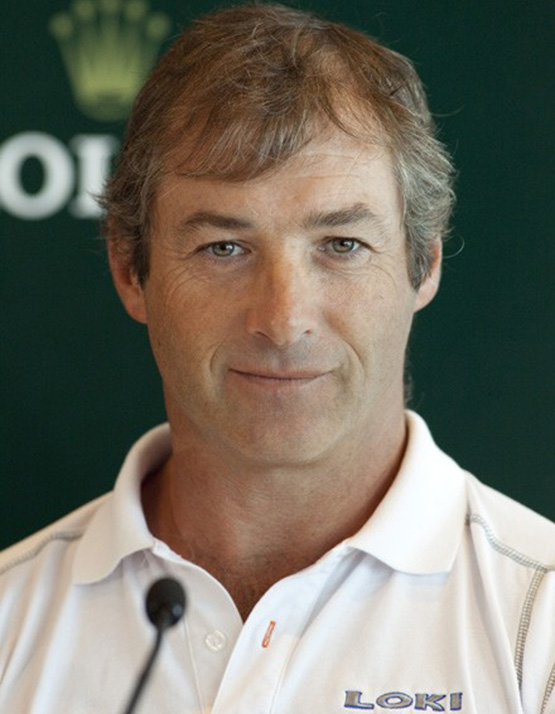 A man fulfilled, Gordon Maguire at the beginning of his hugely successful linkup with Stephen Ainsworth’s RP 63 Loki
A man fulfilled, Gordon Maguire at the beginning of his hugely successful linkup with Stephen Ainsworth’s RP 63 Loki
And Gordon Magure realized that for his talents, Australia was the place to be. More than twenty years later, he was to get his second Hobart Race overall win in command of Stephen Ainsworth’s RP 63 Loki, and here indeed was a man fulfilled, revelling in a chosen career which would have been unimaginable in Ireland.
Harold Cudmore had gone professional as best he could in 1974, but it was often a lonely and frustrating road in Europe. However, his win of the Half Ton Worlds in Trieste in the Ron Holland-designed, Killian Bushe-built Silver Shamrock in 1976 put his name up in lights, and he has been there ever since, renowned for his ability to make any boat perform to her best. It has been said of him when racing the 19 Metre Mariquita in the lightest conditions, that you could feel him getting an extra ounce of speed out of this big and demanding gaff-rigged classic seemingly by sheer silent will power.
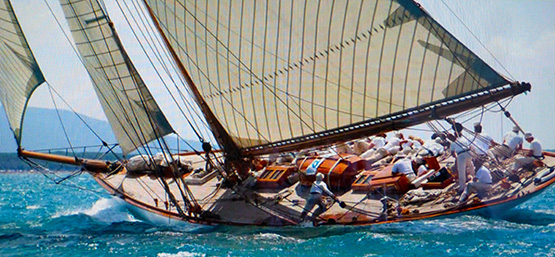
The restored 19 Metre Mariquita is a demanding beast to sail in any conditions…

...but in light airs, Harold Cudmore (standing centre) seems to be able to get her to outsail larger craft by sheer will-power.
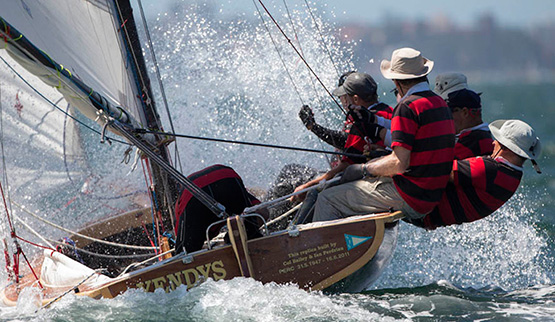 A different scene altogether, but still great sport – Harold Cudmore racing the classic Sydney Harbour 18-footer Yendys
A different scene altogether, but still great sport – Harold Cudmore racing the classic Sydney Harbour 18-footer Yendys
But as for Robert Dix’s fabulous win in 1970, while he went on to represent Ireland in the 1976 Olympics in Canada, he has remained a top amateur sailor who is also resolutely grounded in Irish business life (albeit at a rather stratospheric level). But then it could be argued that nothing could ever be better than winning the Helmsmans Championship of Ireland against the cream of Irish sailng when you’re just 17 years old, and doing it all at the mother club, the Royal Cork, as it celebrated its Quarter Millenium.
It was exactly 44 years ago, the weekend of October 3rd-4th 1970, and for Robert Dix it was a family thing, as his brother-in-law Richard Burrows was Number 2 in the three-man setup. They were on a roll, and how. The manner in which things were going their way was shown in an early race when they were in a tacking duel with Harold Cudmore. Coming to the weather mark, Cudmore crossed them on port, but the Dix team had read it to such perfection that by the time he had tacked, they’d shot through the gap with inches to spare and Cudmore couldn’t catch them thereafter.

Decisive moment in the 1970 Helmsman’s Championship. At the weather mark, Harold Cudmore on port is just able to cross Robert Dix on starboard………Photo W M Nixon
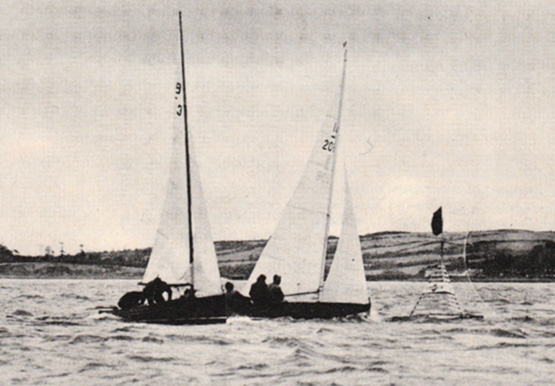 ……but Dix is able to shoot through the gap as Cudmore tacks…..Photo: W M Nixon
……but Dix is able to shoot through the gap as Cudmore tacks…..Photo: W M Nixon
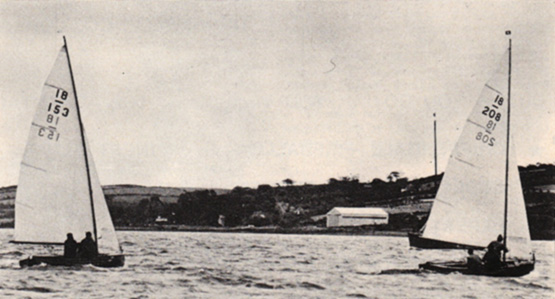 …..and is on his way to a win which will count well towards his overall victory over Cudmore by 0.4 points. Photo: W M Nixon
…..and is on his way to a win which will count well towards his overall victory over Cudmore by 0.4 points. Photo: W M Nixon
Admittedly both Harold Cudmore and the equally-renowned Somers Payne had gear problems, but even allowing for that, the 17-year-old Robert Dix from Malahide was the star of the show, and the final points of Robert Dix 9.5 and Harold Cudmore 9.9 for the 1970 Helmsman’s Championship of Ireland says it all, and it says it as clearly now as it did then.
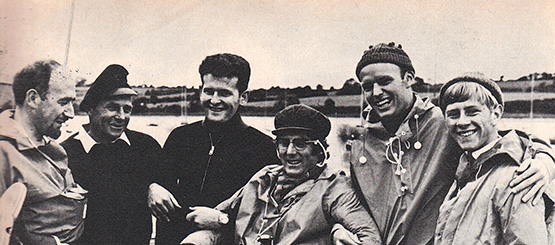
The six finalists in the 1970 Helmsman’s Championship were (left to right) Michael O’Rahilly Dun Laoghaire), Somers Payne (Cork), Harold Cudmore (Cork), Owen Delany (Dun Laoghaire), Maurice Butler (Ballyholme, champion 1969) and Robert Dix (Malahide), at 17 the youngest title holder ever. Photo: W M Nixon
National Yacht Club to Lose Moorings in Front Of Club for 2016
Moorings in front of the National Yacht Club in Dun Laoghaire will be removed next season because of repair works being carried out on the East Pier's Number One berth.
According to an Afloat.ie source, Dun Laoghaire Harbour Company has told the club that a barge will 'operate from the south end of No. 2 berth (Carlisle Pier) and the East Pier and its track being through the existing moorings'.
The NYC has several mooring trots in this location and is used for a dozen or so small boats, RIBs and Ruffian 23 keelboats.
It is understood the moorings will be removed from June 2016 until sometime in 2017.
All Ireland Sailing Championship Invitees Published
Sailor of the year Anthony O'Leary will defend his Irish Sailing Association (ISA) All Ireland Sailing title against 15 other invitees at the National Yacht Club later this month in the ISA's own J80 keelboat fleet.
In a boost for north Dublin sailing, five of the 16 invitees hail from Howth Yacht Club and there are four are drawn from the ranks of the ICRA cruiser–racing divisions but there is no ICRA Zero invitee on the list. The RS400s are sending Alex Barry of Monkstown, the Flying fifteens are fielding David Gorman who will race from his home club. From the clinker classes the Shannon One Designs will be represented by Frank Browne of Lough Ree, the Mermaids by Patrick Dillon of Rush Sailing Club and the IDRA 14s by Alan Henry of Sutton DC. Michael O'Connor will race for the SB20s. (See invitee list below)

David Gorman (left) and Chris Doorly will represent the Flying Fifteens
The ISA published its invitation list last Friday and says its selection process for the event is 'in full swing'. So far though there appears to be no representation from a number of one design classes including: J24, Dragon, 1720, J109, Sigma 33, Puppeteer or Fireball dinghy classes or any of the Olympic team. The ISA notes it 'did not receive valid nominations from any of the other Class Associations'. Class Associations, it says, were 'asked to provide their nominations for their best sailor', and the previous year's champion is asked to return to defend the title.
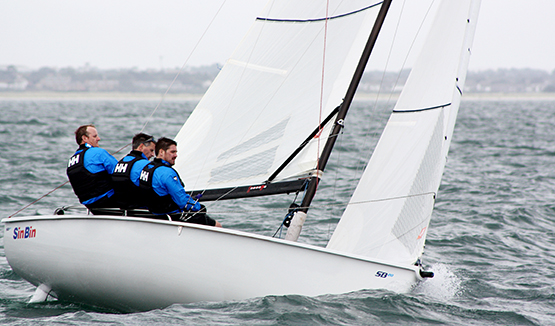
Michael O'Connor (left) represents the SB20s at the All Ireland Sailing Championships on October 3 at the National YC
As Afloat previously reported the ISA All Ireland's take place from 3-4 October. The closing dates for nominations was September 21st 2015.
No wild card entries have been published so far.
|
2014 Champion |
Anthony |
O'Leary |
RCYC |
|
|
RS400 |
Alex |
Barry |
Monkstown Bay SC |
|
|
GP14 |
Niall |
Henry |
Sligo Yacht Club |
|
|
Shannon OD |
Frank |
Browne |
L Ree YC |
|
|
Flying Fifteen |
David |
Gorman |
National YC |
|
|
Squib |
Fergus |
O'Kelly |
Howth YC |
|
|
ICRA 1 |
Roy |
Darrer |
Waterford Sailing Club |
|
|
Mermaid |
Patrick |
Dillon |
Rush SC |
|
|
Laser Std |
Ronan |
Cull |
Howth YC |
|
|
SB20 |
Michael |
O'Connor |
Royal St.George YC |
|
|
IDRA14 |
Alan |
Henry |
Sutton DC |
|
|
RS200 |
Frank |
O'Rourke |
Greystones SC |
|
|
ICRA 2 |
Simon |
Rattigan |
Howth YC |
|
|
ICRA 4 |
Cillian |
Dickson |
Howth YC |
|
|
Ruffian |
Chris |
Helme |
Royal St.George YC |
|
ICRA 3 |
Niamh |
McDonald |
Howth YC |
The ISA has issued an explanation on the selection process for this year's event as follows:
The Irish Sailing Association (ISA) received nominations from sailing classes across the Nation. Last year's champion Anthony O'Leary received an automatic place, and the remaining places were selected from the 22 classes that submitted a valid nomination. The three largest dinghy classes and the three largest keelboat classes receive six places, and the next six largest classes on the list receive the next six places. The steering group decided to continue down the list of classes in order of fleet size at their respective National Championships. All classes invited accepted, with the exception of the laser radial nominee who was not available, so the next on the list was ICRA 3 who accepted, and completed the lineup.
Local Sailing Class Success Takes Good Boats, But Even Better People
As we near the end of the traditional sailing season, inevitably there’ll be heart-searching among boat owners as to the success and value obtained from their summer afloat – can they really justify the expense of continuing to keep a boat? And with so many imponderables in our sport after a summer which was decidedly mixed in its weather - to say the least - the larger sailing community will be scrutinising those classes which seem to be barely hanging in, those classes which are doing quite well, and those few classes which are spectacularly successful. W M Nixon takes a look at the International Dragons in Glandore, the Flying Fifteens in Dun Laoghaire, and the Puppeteer 22s in Howth to try and find that magic Ingredient X which helps - or has helped - these three very different examples to stay ahead of the game.
The wish to own a boat is a vocation, a calling, a quasi-religious emotional endeavour. It’s all very well for high-flown consultants to tell us that if sailing is going to have general appeal and expand, then publicly-accessed freely-available try-a-sail boats will have to be based at every major club. But dedicated sailors know that what comes easy, goes easy. A spell of bad weather, and your jolly public groups who turned up in droves for a bit of free fun afloat will disappear like the will-o’-the-wisps they were in the first place, seeking instead to find somewhere warm and bright and out of the rain and readily providing the latest novel form of entertainment.
Meanwhile, those who are dyed-in-the-wool boat addicts will have barely noticed the idly-interested strangers coming and going. For whatever the weather, they’ve a boat to maintain, gear to repair, a crew to keep together, and some sensible purpose to find in order to give it all deeper meaning. For they know that unless they’ve a boat and her problems and possibilities occupying a significant part of their mind, they’re going to lose the plot completely.
Nevertheless, in the huge spectrum of boat ownership and sailing classes, why is there so much difference in the successful buzz created by some classes at certain localities, as opposed to the dull and declining murmur emanating from classes which are clearly on the way out?
After all, there are very few utterly awful boats afloat. No boat is completely perfect, though some may seem less imperfect than others. But in today’s throwaway world, if some class of boat is not a reasonably good representative of her general type, then she’ll never make the grade in the first place. And even in times past when news and views moved more slowly, the word soon got around if some much-touted type of boat was in truth a woofer.
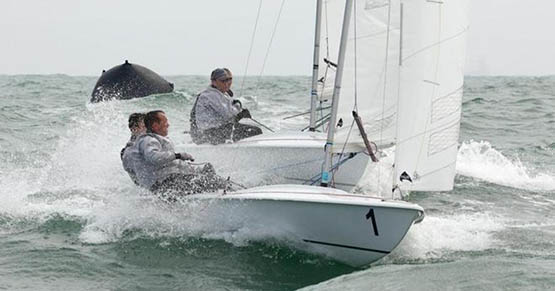
Flying Fifteens provide the best of sport in a very manageable two-man package

The perfect harbour for vintage International Dragons – Glandore, with a goodly selection of classics in port, and Dragons of all ages dotted among them
That said, boat-owning is such an all-consuming passion that once a sailor has finally (or indeed hastily) committed to a particular boat type, then he or she will tend to be absurdly dismissive of any remotely comparable craft. But in the last analysis, the desire to own a boat is irrational. So we shouldn’t be surprised that once the decision is made, irrational attitudes manifest themselves in every direction.
And anyway, as John Maynard Keynes once remarked in a totally different context, in the last analysis we are all dead. So in the meantime, it behoves us to get as much reasonable enjoyment out of life as possible. Thus if owning and sailing a boat is your way of obtaining pleasure without harming anyone else, then good luck to you and me, and let’s look together at boat classes which are doing the business.
In considering the International Dragons in Glandore, the International Flying Fifteens in Dun Laoghaire, and the emphatically not-international Puppeteer 22s in Howth, we are indeed casting the net wide, for really they couldn’t be more different. The 29ft International Dragon originated in the late 1920s from the design board of Johan Anker of Norway, and she has become a by-word for Scandinavian elegance in yacht design, but today she’s totally a racing machine and has strayed far from her original concept as a weekend cruiser for sheltered waters.
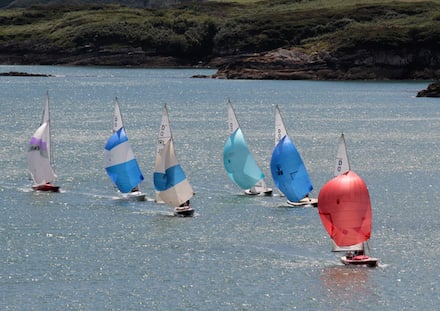
Golden days of classic Dragon racing at Glandore
As for the Flying Fifteen, they originated from designer Uffa Fox having a brainstorm in 1947, in that he took the underwater hull section of the renowned International 14 dinghy in which he was something of a master both as designer and sailor, but above the waterline he drew out the bow to an elegant curved stem, then he lengthened the gentle counter lines to finish in a long sawn-off transom. That done, he added a little hyper-hydrodynamic bulb ballast keel which seemed very trendy, but in truth it’s severely lacking in useful lateral resistance. Nevertheless it gives the boat the reassuring feel of being a small keelboat rather than a big dinghy, and atop it all he put the rig of an International 14 dinghy of that era.
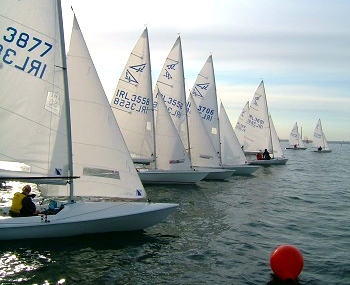
The clean lines of a modern Flying Fifteen fleet. Try to imagine that within each hull there’s an International 14 dinghy, and above it is the original rig
The result was a boat which is really only useful for racing, and it is a design so much of its times that it’s said that many years later the designer himself tried to disown it. But the owners would have nothing to do with this, they liked the compact and very manageable racing-only package which the Flying Fifteen provides, and these days the class has an interesting world spread, and an attractive policy of staging their World Championships at agreeable sunshine destinations where – thanks to their guaranteed ability to turn up with a fleet of viable size – they can arrange block discounts to provide the owners with a very appealing package.
After the sheer internationality of the Dragons and the Flying Fifteens, the Puppeteer 22s are something of a culture shock, as almost every one in existence has ended up based in Howth, where they have such a busy club programme that they only very seldom go south of the Baily, though they do have one annual adventure to Malahide for the Gibney Classic, and once a year they take part in the historic Lambay Race. But otherwise, they’re totally and intensely focused on club racing off Howth.

The Puppeteer 22s seldom stray far from their home port of Howth, for at home they get superbly close racing with a fleet of up to 26 boats in evening racing. This is former ISA President Neil Murphy racing hard at the helm of Yellow Peril, neck and neck with Alan Pearson’s Trick or Treat. Photo: W M Nixon
They were designed by Chris Boyd of Strangford Lough in the mid 1970s to be fractionally-rigged mini-offshore racers, and in all about thirty-three of the Puppeteer 22s were built by C & S Boyd in Killyleagh (Sarah was Chris’s wife). For a while it looked as though they might take off as a semi-offshore One Design class in the north, but somehow they began to trickle down to Howth. They appealed to those sailors who felt that the alternative of a Ruffian 23 with her huge masthead spinnaker was a little too demanding on crews, whereas the Puppeteer’s fractional rig is fairly easily managed. And today the class in Howth is in such good health that even in the poor weather of 2015 they were obtaining regular midweek evening racing best turnouts of up to 26 boats.
Obviously the Puppeteer 22s are now very much a completely localised phenomenom. But while the Flying Fifteens in Dun Laoghaire and the Dragons in Glandore may be representatives of well-established international classes, the fact is in both cases their neighbourhood success is largely due to a distinct local flavour driven by individual enthusiasm. And in Glandore while it’s recognized that the vintage Dragon class was started by Kieran and Don O’Donohue with the classics Pan and Fafner, the man who beats the drum these days for the racing at Glandore as providing “the best and cheapest Dragon racing in the world” is the inimitable Don Street.
Most people will expect that they will be slightly older than the boats they own, and the older you get the greater you’d expect the age gap to be. But Don’s classic Dragon Gypsy is 82 years old. Yet Don himself manages to be that proper little bit senior to her, as he’s 85 and still full of whatever and vinegar, as they’d say in his native New England.
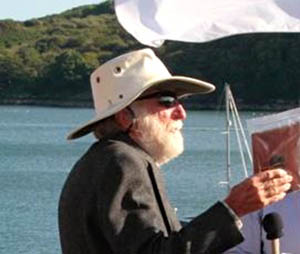
The one and only Don Street in his beloved Glandore. His International Dragon Gypsy is 82 years old, but he still manages to be the senior partner at 85.

Conditions are pleasantly sheltered for the Dragons in Glandore Harbour, but when the fleet goes offshore – as seen here for last year’s championship - they can find all the breeze and lively sea they might want, and more.
The things that Don has done with Gypsy – between intervals of the renowned ocean voyaging with his 1905-built yawl Iolaire which he has now sold – are remarkable, as he sailed Gypsy from Glandore to the classic regatta in Brittany, which is a prodigious offshore passage for an open cockpit racing boat along what the rest of the world would see as significant portions of the most exposed parts of the Fastnet Race course.
Yet although he did such wonderful business with Gypsy on great waters, he has no doubt that the secret of Glandore Dragon racing’s local success is the sheer nearness and convenience of it all. “Down to the pier and out to the boat in five minutes, the starting line is right there, and we don’t race those boring windward-leewards, rather we use club buoys, government navigation marks, islands - and lots of rocks……”
His argument is that with lovely Glandore Harbour being such an fascinating piece of sailing water, part of the interest in keeping up the pace in a local class lies in using those local features, rather than pretending they simply don’t exist by setting courses clear of the land. But of course when the Glandore fleet – which continues as a mix of classic wooden and glassfibre boats – hosts a major event such as last year’s Nationals – which was won by Andrew Craig of Dun Laoghaire in Chimaera – then the courses are set in open water, and they’d some spectacular sailing with it.
In many ways Glandore is a special case, as the population swells in summer with people coming for extended vacations. When that’s the case, their commitment to local Dragon racing can be total, and not least of the occasional local summertime alumni is the great Lawrie Smith. He may have won the Dragon Gold Cup from a fleet of 66 boats last month in Germany under the burgee of another club, but when he’s racing Dragons in Ireland, he’s emphatically under the colours of Glandore Harbour Yacht Club.
Despite these glamorous international links, it’s the folk on the home ground with their dedication to the Dragon Class in Glandore who keep it all going, and it’s Don Street with his dogged determination to prove you can run a Dragon out of pocket money, regardless of the megabucks some might be ready to splash out, which gives the Glandore Dragons that extra something. And in the end it’s all about people, and shared enthusiasm. If you’ve a warm feeling about the Dragon class, and particularly for classic boats in it, then you know that in Glandore you’ll find fellow enthusiasts and every encouragement.
But up in Dun Laoghaire, if you take a look over the granite wall on to the east boat park at the National Yacht Club in summer, and see there the serried ranks of apparently totally identical Flying Fifteens all neatly lined up on their trailers, you could be forgiven for thinking it’s all just ever so slightly clinical, and certainly distinctly impersonal.
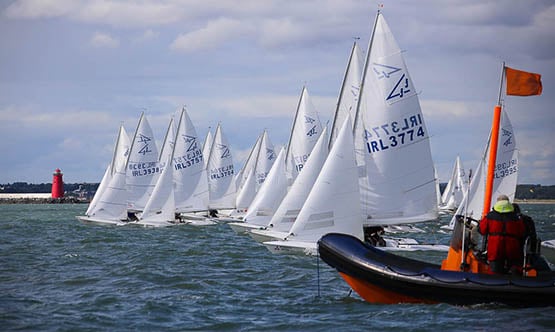
Just about as one design as they could be – the fine fleet at last weekend’s Flying Fifteen Irish Championship in Dublin Bay showed the vigour of the class, which has 47 ranked helmsmen in this country.
Yet you couldn’t be more utterly wrong. Today’s Flying Fifteens may have been technically refined to the ultimate degree to give maximum sport for the minimum of hassle. But their current runaway success – they’re far and away the biggest keelboat One Design class in Dublin Bay – is down to a friendly and very active local class association, and its readiness to reach out the hand of friendship and encouragement to anyone who might be thinking of joining the class’s ranks.
Recently the pace has been set by class captain Ronan Beirne, who recognises that simply announcing and advertising an event is not enough. You have to chivvy people and encourage them into their sailing – particularly after a summer remembered as having had bad weather – and then far from sitting back and smugly counting numbers, you have to keep at it, seeing that crewing gaps are filled, and that those on the fringes are brought to the centre.
The Flying Fifteens – which are essentially a National YC class – offer exceptional value and a very manageable package. The boats are dry-sailed in their road trailers, and instead of queuing for a crane, they have a rapid rota of slip-launching, with the expectation of renewing the wheel bearings each year. Salt water and road trailers are not good partners, but in order to ensure the most efficient launching and retrieval of the boats after each day’s racing, replacing wheel bearings has become something of an art.
The class in Dun Laoghaire secured good sponsorship from Mitsubishi Motors at the beginning of the year, and the sponsors in turn have been rewarded by a thriving class in which inter-personal friendships have developed to such a healthy state that you might find people crewing for someone who would be a complete and untouchable rival at other times in many other classes, but in the Dun Laoghaire Flying Fifteens he’s a fellow enthusiast who happens to be short of a crew on that day.
One of the enthusiastic newcomers to the class this year is Brian O’Neill, who originally hailed from Malahide and was best known for campaigning the family’s Impala 28 Wild Mustard with great success for several years, but now he’s very much a family man living in Dun Laoghaire with three growing kids, and sailing had gone on to the back burner.
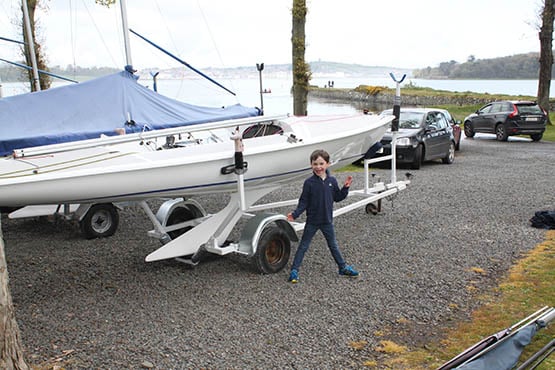
Charlie O’Neill (aged 7) at Strangford SC with dad Brian’s newly acquired Flying Fifteen. Under the rapid moving launching system at the National YC, the dry-sailed Flying Fifteens use their road trailers to get the boats afloat in record time. The need for regular replacement of the wheel bearings is allowed for in each boat’s budget. Photo: Brian O’Neill
But as the National YC is just down the road from where he lives, he was drawn into its welcoming ambience, and soon became aware of the attractive and friendly package offered within the club by the Flying Fifteens. He bought one in good order from an owner at Strangford Sailing Club in the Spring, and was soon in the midst of it. Yet it takes up only a very manageable amount of his time, it simply couldn’t be more convenient, and the people are just great too.
Who knows, but having won the class’s last evening race of the 2015 season, he might even be prepared to travel to maybe one event at another venue in Ireland. But the primary attraction continues to be the class’s strong local ethos and ready racing at the National, the friendliness of fellow Flying Fifteen sailors, and the sheer manageability of the whole thing – this is not a boat where the ownership gets on top of you.
If you want to get the flavour of Dun Laoghaire Flying Fifteen racing, you get a heightened sense of it from the report in Afloat.ie of how David Gorman and Chris Doorly won last weekend’s Irish championship in classic style, and if this isn’t good value in sailing and personal boat ownership, then I don’t know what is.
Across Dublin Bay in those misty waters of Fingal beyond the Baily, your correspondent found himself reporting aboard Alan “Algy” Pearson’s Puppeteer 22 Trick or Treat last Saturday for the opening race of the MSL Park Motors Autumn League. I did so with some trepidation, for Alan has a super young crew recruited from Sutton Dinghy Club in the form of GP14 ace Alan Blay, Ryan Sinnott and Claud Mollard, but our cheerful skipper said that as the day was brisk, they needed the fifth on board for ballast.
In fact, I’d only once raced a Puppeteer before, in the lightest of winds when somehow we managed a win. But as this race progressed with the skipper and his young tacticians making a perfect call for the long beat in a good long course which made full use of the splendid sailing waters north of Howth, by the last leg after many place changes it looked as though another win might be on the cards.

Action stations. Puppeteer 22s closing in for their start. Photo: W M Nixon
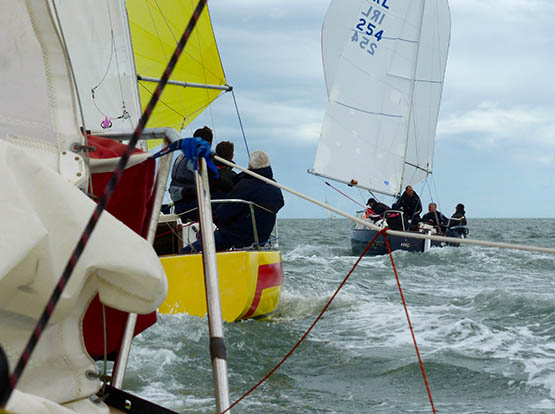
At mid-race, Gold Dust led narrowly from Yellow Peril, but by the start of the last beat, Trick or Treat was leading from Gold Dust with Yellow Peril third. Photo: W M Nixon
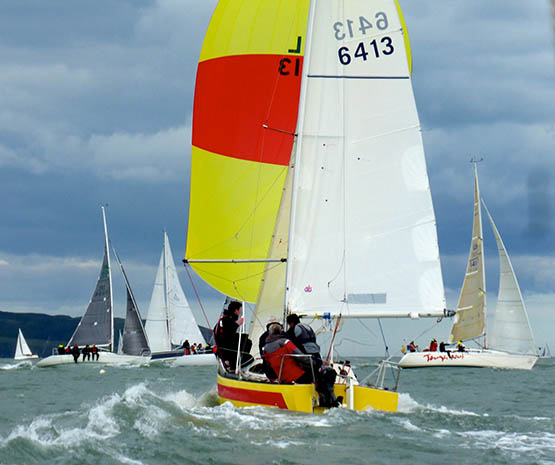
In the MSL Park Motors Autumn League, the mix of classes can sometimes make for interesting situations. Having out-gybed Gold Dust, Yellow Peril is ploughing towards some biggies on another course altogether, and meanwhile there’s the inevitable lobster pot lurking on the way with just one tiny white marker buoy. Photo: W M Nixon
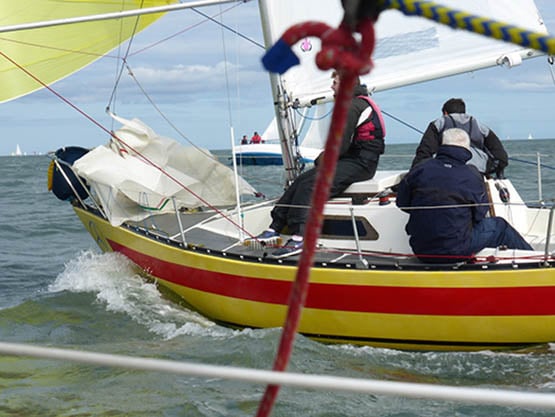
Algy Pearson’s Trick or Treat giving Yellow Peril a hard time to snatch the lead, which she then increased with a cleverly-read long beat. Photo: W M Nixon
But the pace in the Puppeteers is ferocious, and though we’d got a bit of a gap between Trick and former IDRA 14 empress Scorie Walls in Gold Dust, one sneeze from us and Gold Dust would pounce, and alas - we sneezed.
As long as we were carrying the no 2 headsail (what I’d call the working jib) we were level pegging with the formidable Walls-Browne team. But Gold Dust has a lovely new suit of sails (nice ones, Prof), and when the easing wind meant we’d to change up to the genoa, it emerged as a sail of a certain age, and having it set sapped our confidence.
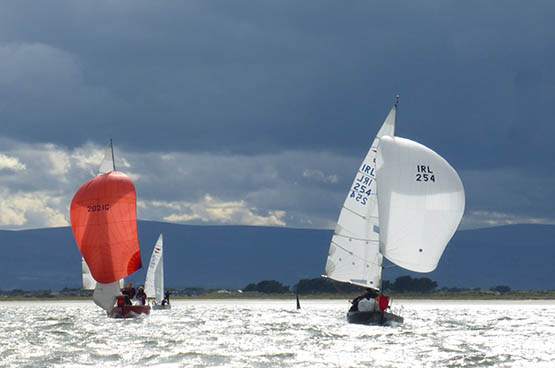
It looked for a while as though Gold Dust (254) had been put fairly comfortably astern……..Photo: W M Nixon
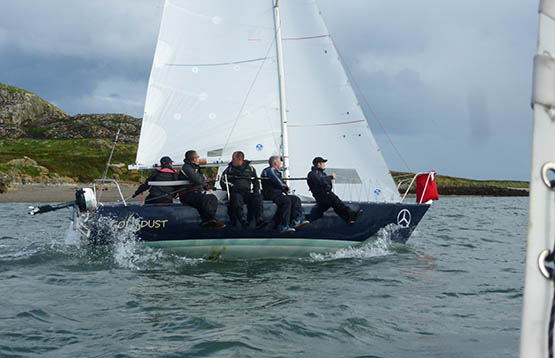
……but an easing of the wind saw Gold Dust finding new speed, and with perfect tactics she was right there with just a hundred metres to go to the finish. Photo: W M Nixon
Until then, the boat had been sailed magnificently, tactics right, trim right, and throwing gybes with such style that the downwind pace never missed a beat. But trying to get that genoa right was a mild distraction, so when Scorie the Queen of the Nile came round the final mark to chase us up the last beat to weather Ireland’s Eye, we’d failed to throw a precautionary tack to keep a loose cover, and suddenly as she rounded she found a local favourable but brief shift of 15 to 20 degrees, and then it was all to play for.
Dissecting it all afterwards (you’ll gather it was a post mortem), we could see two places where we might have still saved the day, but we didn’t grab them, or maybe in truth they were beyond our reach. Whatever, Gold Dust was in the groove and we weren’t. Madam beat us by three seconds. But the banter afterwards and the evidence that Puppeteer people – owners and crews alike – move happily among boats to keep turnout numbers up, was ample proof that here was another truly community based class which perfectly meets a strong local need.

That winning feeling…..Gold Dust’s crew relax after taking first by three seconds. Photo: W M Nixon

The Howth experience. Howth YC Commodore Brian Turvey heads back to port after racing the MSL Autumn League with the Howth 17 Isobel which he co-owns with his brother Conor. Photo: W M Nixon
It had been a great day’s sport, and the Puppeteers being of an age and regularly turning out to race together, they run both a scratch and a handicap system, which is a great improver of local classes – after all, where would golf be without handicaps?
It shows how well Gold Dust has been going this year that her rating is such that we beat her on handicap by one minute and 19 seconds, but we in turn, having been second on scratch, were fourth on handicap, where the winner was the O’Reilly/McDyer team with Geppeto.
Forty years after they first appeared, the Puppeteer 22s are giving better sport than ever, but in a very local context rather than on the bigger stage that might have been anticipated. Yet for their current owners, they do the business and then some. For most folk, this is sailing as it should be. And as to this longterm success of classes which continue to thrive whether they come from a local, national or international background, certainly the quality of the boats is important to some extent. But mostly, it’s the people involved, and their realization that you’ll only get as much out of sailing as you put into it.
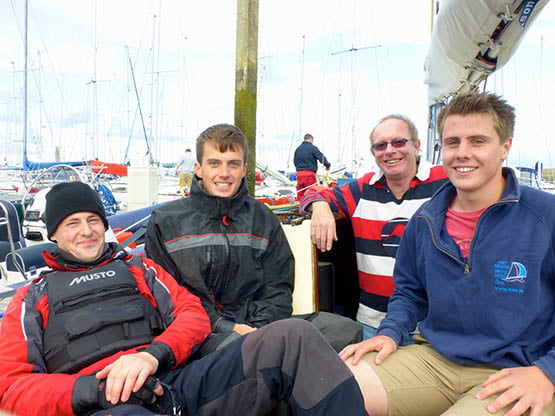
A super crew. Aboard Trick or Treat after racing are (left to right) Alan Blay, Ryan Sinnott, Alan Pearson and Claud Mollard. Photo: W M Nixon

Local man, local boat. Algy Pearson with his Puppeteer 22 Trick or Treat. The Pearsons have been sailng from Howth for three generations. Photo: W M Nixon
How We Won The Flying Fifteen Irish Championships 2015
As Afloat.ie reported on Sunday, David Gorman and Chris Doorly of the National Yacht Club won the 32–boat Mitsubishi Motors Flying Fifteen Championships of Ireland at the weekend beating a visiting triple world champion in the process. Here Chris Doorly describes how the cup was won.
The Notice of Race for National Championships should carry a health warning, both for physical and mental well being! Going up the last beat of Race 6 on Sunday morning we were in sixth place, we needed to be third to win the event and avoid sailing the last race (quiet a luxury really!) The legs were burning, the wind was fickle and the mind was playing games on us, were we going to lose out and leave it all to the last race?
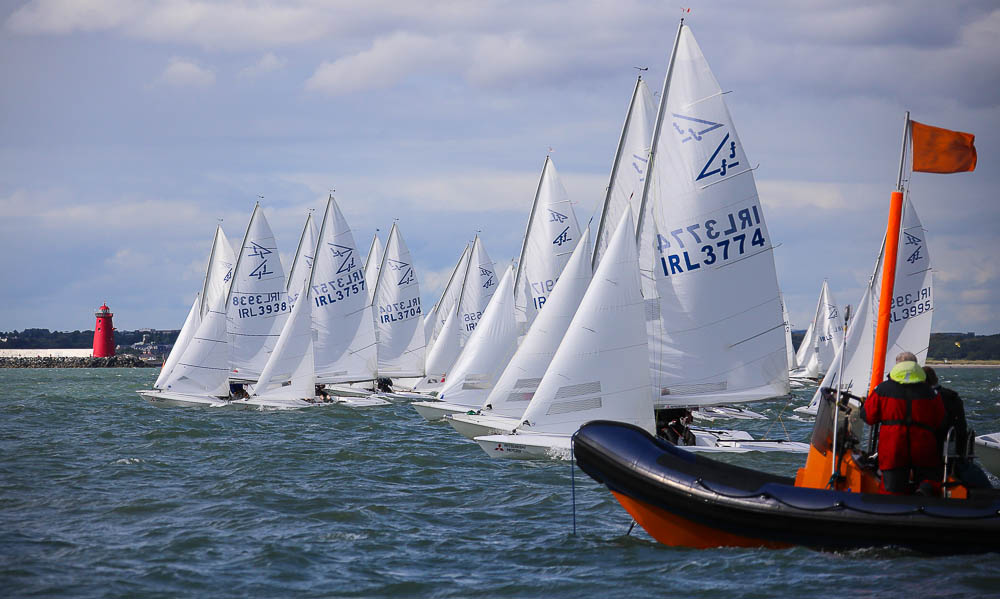
The 32–boat championship fleet start race five
It was not a pleasant thought, patience and calmness were the order of the day, we checked in with our inner mind and settled down to just do what we always do, stick to the process just like the rugby lads! Soon after the leeward gate we got past Brian O’Neill and then Tom Murphy, up to fourth, would it be enough, Dave thought it might be. Last year’s winners Andy and Dougie were in good form today and it was far from a given that we would pass them.
As we approached the weather mark Steve Goacher was leading followed by Sean Craig, we watched the water for pressure it was now light in most places, where would the wind come from next? we saw texture on the water to the right and noticed Steve had a bit more pressure, also at the right as he rounded the mark, we took the risk and went in on port to the right side, on the lay line we tacked and we crossed the lads, third place! Downwind the wind was still light and all over the place, it was a long 1.2 miles to the gate and finish! There was total concentration on the spinnaker. We stayed close to them deliberately, or were they staying close to us waiting to pounce? We just managed to stay ahead gybing at the leeward mark on the inside and crossing the line in third, we had done it! There was great delight on board so much so that some on the committee boat were wondering why we were celebrating after getting third in a race!
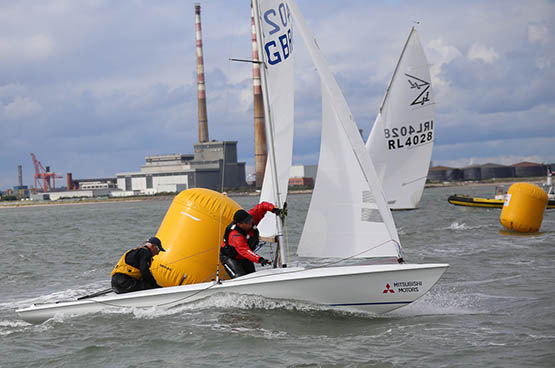
Steve Goacher and Martin Grady prepare for a hoist
It was a three day event with racing starting on Friday, we like the three day events as we tend to go well in all conditions and are not heavy or light weather specialists. In the build up we would have been considered one of the favourites, a tag that means very little in sailing, but with the entry of Steve Goacher and Sean Craig our expectations were dampened but we were determined to give it our best shot.
There was a severe weather forecast for Saturday in particular and it was blowing over 20knots on Friday at the briefing. International race officer Jack Roy and his team put on three races on Friday in case Saturday got cancelled. On the water the 20knots had disappeared and Jack put up the AP. Eventually we got going, there was a general recall on the first start but on the restart the pin was biased and we nailed it, this was critical as the boats at the pin end were the lead boats for the race, Steve led the way at the weather mark and to our surprise we passed him downwind just before the gate, our joy and confidence boost were short lived as the tide pushed us up against the mark and we had to do our turns, we carried on finishing second to Steve with Brian Willis third and Sean Craig fourth, it was good to start with a counter.
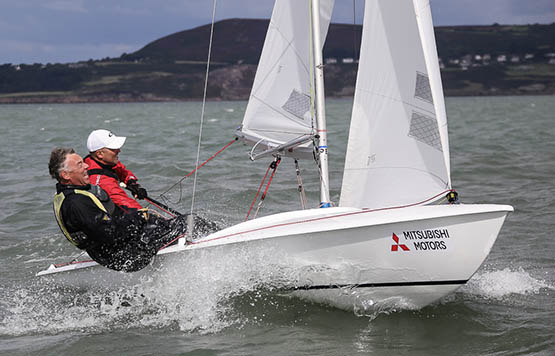
Sean Craig and Alan Green finished third overall
In racing you need a little luck, in race 2 in light conditions we finished second as we were out on what ended up the favoured left side, some would call it the windier side, with Sean Craig who won the race, Steve was on the right and got caught out to finish seventh. Similarly in Race 5 on Saturday in the westerly winds we had spotted wind on the right and got a fantastic 20 degree lift up to the mark as our competitors were on the left side, we went on to win this Race while Sean was fourth and Steve fifth. In saying that we aware that while left into the shore generally pays it was not always the case and our eyes were scanning the course for wind. On Saturday night we had a four point lead but from previous experience we knew that it may not be enough but were delighted to be in the lead and in contention.
Roll on race six on Sunday where we managed the required third place to take the cup back to the National Yacht Club. Race seven was windier with some exhilarating downwind sailing to round of a fantastic weekend of sailing. Again Goacher and Craig didn’t have it all their own way as local boys Ian Mathews & Keith Poole and last years champions Andy McCleery & Colin Dougan took off to be first and second with Steve third, Sean piped us on the line to take fourth place but this was to be our discard.
Thanks to Jack Roy and his race team, the race office, the National Yacht Club and to the local class captain Ronan Beirne along with all the competitors who all did a great job ensuring the success of this event.
Liam Shanahan’s 'Ruth' Retains ISORA Offshore Championship Crown
The last race of the ISORA Avery Crest Offshore series that was sponsored by LC Tyres, took place on Saturday 12th September with the race from Pwllheli to Dun Laoghaire (74 miles) writes ISORA's Peter Ryan. The boats compete for the famous “James Eadie” trophy. As like the same race last season, the weather forecast for the race and particularly the delivery to Pwllheli was not favourable all week. This put off many of taking part in what is normally a well supported end of season race.
The race was of more interest than usual due to the fact that the Overall Championship was still be be raced for with Liam Shanahan’s J109, “Ruth” and Andrew Hall’s J125, “Jackknife” only a 5 point apart and Peter Dunlop and Vicky Cox’s J109 “Mojito” close behind. While either “Ruth” or “Jackknife” could have taken the Series with a good result in the race, “Mojito” needed a well attended race to secure sufficient points in the high points scoring used by ISORA.
Of the 26 entries received for the race, 19 had confirmed taking part on the Monday prior to the race but only 9 came to the start on Saturday morning. Several boats had left Dun Laoghaire the previous morning but turned back when they were met with strong south easterly winds on the nose and a big sloppy sea. Those that persevered were rewarded with nearly “champagne” sailing for the race. Bryan Mullarkey’s Collins 40, “Harriet Marwood” was taking part in an ISORA race for the first time. Richard Mossop’s Oceanis 411, “Yachtzee” and David Simpson’s Swan 371 “Albeiro” were battling for the Overall Class 2.

Liam Shanahan's Ruth from the National Yacht Club has successfully defended her 2015 ISORA offshore crown
Due to the uncertain forecast due to the presence of two depressions, north and south of the race area, the decision was taken to set the course from the start direct in Pwllheli to the finish between the pier heads in Dun Laoghaire.
Despite the poor forecast, the lashing winds during the night and the strong winds, conditions were relative pleasant for the start. The wind was 10-12 knots from the south west giving a beat to the first corner at St Tudwal’s Sound. Stephen Tudor’s J109, “Sgrech” was first off the line and lead the fleet until the faster “Jackknife” too to the front. From the start “Ruth” and Mojito” were always in close contact leaving.
As the fleet approached St Tudwal’s Sound the wind had increased to 20knots and the expected overfalls at the end of the sound awaited the fleet. The next leg was the beat to Bardsay Sound. The wind appeared to veer westerly and maintained the 20-22 knots leaving the fleet to beat through the rough seas towards Bardsey Sound. Fortunately, the tide was right for a fast shoot through Bardsey Sound. Unfortunately, the overfalls in the sound were significant but had settled soon after exiting it.

By that stage the battle was on. “Jackknife” cracked sails and took the direct line to Dun Laoghaire in the last of the north going tide. The remainder of the fleet retained their height and the three J109’s with Conor Fogarty’s 2-handed Jenneau 3600, “Bam”, bunched together for the leg to Dun Laoghaire. Shortly after leaving Bardsey the wind backed allowing the boats to ease sails and speed up. Of the bunch of four, “Bam” lead the group with “Ruth” and “Mojito” close behind and “Sgrech” snapping at their heels. Paul Sutton’s “Pipedreamer VI” was just behind this pack.
As the fleet approached the Irish coast the winds abated to 12 knots and backed further to the south allowing those with Code Zeros to accelerate. The positions within the fleet did not change for the long leg despite continuous trimming and hard driving being done on all the boats. It was not until approaching Dublin Bay that “things started to happen”. The winds became fickle and dropped further in Killiney bay. While “Jackknife” avoided much of the light wind to keep powering towards the line, the three J109’s and “Bam” got into a tactical battle with rapid sail changes taking place to deal with the oscillating winds. As the fleet approached Dublin Bay the wind veered to the west and decreased again giving the boats a short final beat to the finish line. Despite the work on each boat the positions generally remained the same.
“Jackknife” took line honours but could only manage 5th Overall allowing “Ruth”, who won the Overall race and Class1 to regain the ISORA Avery Crest Offshore Championship title. Class 2 was won by “Yahtzee” who also won Silver Class.
The crew of Liam Shanahan’s “Ruth” include his four sons. There is a great tradition of offshore racing in the Shanahan family with Liam Shanahan Snr playing a huge part in ISORA racing in the early days.
The race sponsor, LC Tyres, provided day prizes for the race. These were presented at the après sail party that took place in the NYC. The prizes were presented by Caroline Coyne aided by her son, Billy and daughter, Isobel.
The ISORA Avery Crest Offshore Championship trophy, the Wolf’s Head, will be presented to Liam Shanahan at the ISORA dinner in the NYC on the 14th November. “Jackknife” took 2nd place Overall and “Mojito” took 3rd place.
Overall Series Calls 1 was won by “Jackknife” and Class 2 was won by “Albeiro” who also took Overall Silver Class. The team prize, known as the “Victoria Cup”, was again won by Pwllheli Sailing Club.
All the results can be found on the ISORA website. The YB tracking of the race can also be accessed on the ISORA website and on the YB app for smart phones.
Dublin Flying Fifteen Duo Beat Triple World Champion for Irish Title Win on Home Waters
The National Yacht Club's David Gorman and Chris Doorly completed a text book win of the seven race Mitsubishi Motors Flying Fifteen national championships this afternoon, beating in the process the pre–championship favourites, visitors Steve Goacher and Martin Grady from Lake Windemere.
The former triple World Champion finished four points behind Gorman and Doorly who sailed a very consistent series in light and medium winds to count six top three results to finish this afternoon on 12 nett points. Third overall was the Royal St. George Yacht Club's Sean Craig sailing with Alan Green on 16 points, the same score as Goacher who took second place on the tie–break rule.
Full results for the 32–boat fleet are downloadable below.
The fine Irish turnout was only marginally below the 36–boat fleet assembled for this year's British Isles Championships.
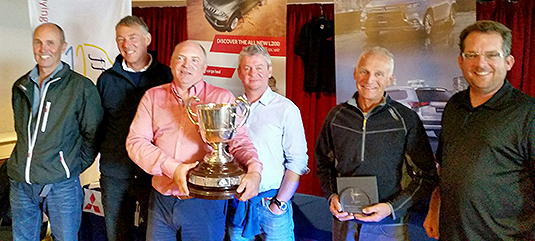
Flying Fifteen podium at the National Yacht Club – From left Sean Craig and Alan Green (third overall), Chris Doorly and David Gorman (winners) and Steve Goacher and Martin Grady (second overall)
Read also: How We Won The Flying Fifteen Irish Championships 2015
World Champion Steve Goacher Joins the Flying Fifteen Fray on Dublin Bay
Triple world Flying Fifteen champion Steve Goacher will sail in this afternoon's Irish national championships sponsored by Mitsubishi Motors. The Lake Windermere sailor is one of a number of visitors for the bumper championships that has attracted a fleet of 32–boats from eight different sailing centres to the National Yacht Club.
More on the event in this morning's Irish Times Sailing Column here.
The first race of the seven race series is on Dublin Bay this afternoon at 2pm but the big question this morning is how strong will forecasted weekend winds blow?
Be careful out there, some horrible weather is on the way http://t.co/4nzr6otADd Pic: @darkskyapp pic.twitter.com/51qTSWxikI
— TheJournal.ie (@thejournal_ie) September 10, 2015




























































